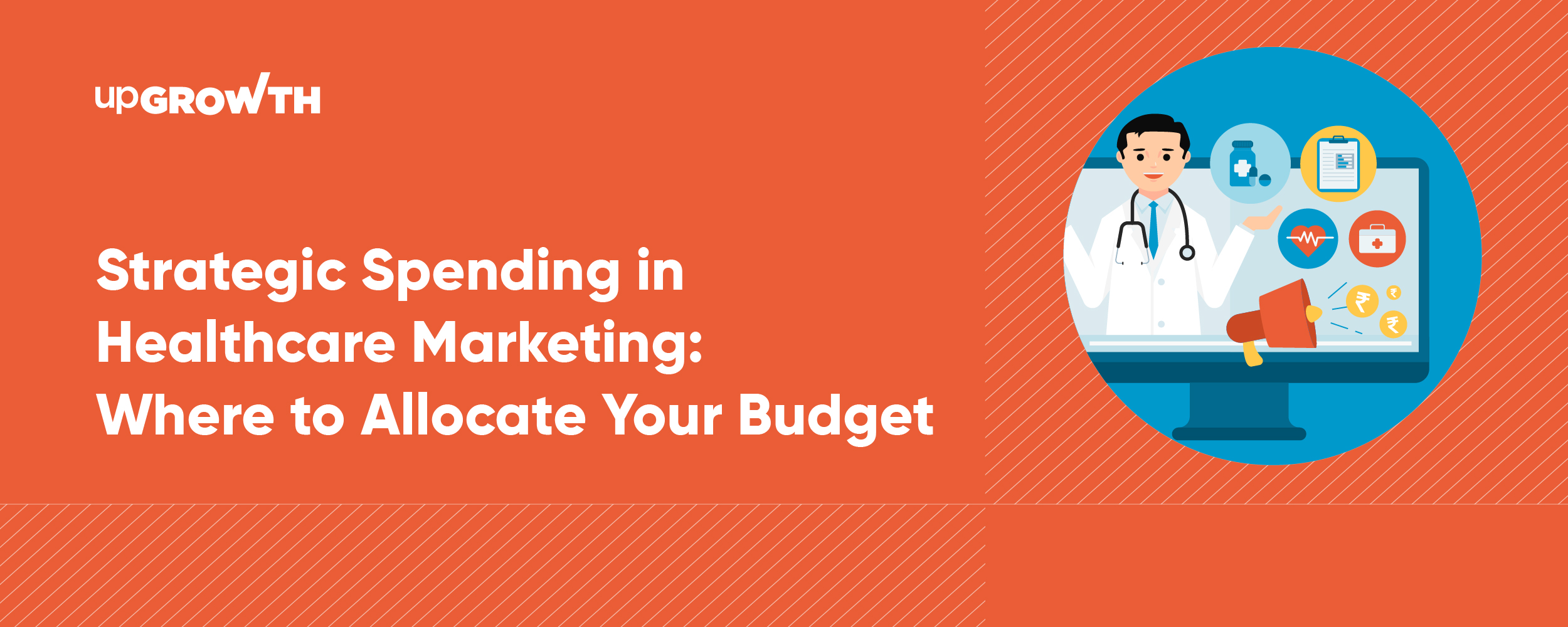Strategic Spending in Healthcare Marketing: Where to Allocate Your Budget
Contributors:
Amol Ghemud
Published: March 14, 2024

In today’s healthcare landscape, the battle for patient acquisition is fierce. Gone are the days of a single local hospital dominating its community. Now, a dynamic web of clinics, specialists, and health systems vie for the ever-evolving needs of patients. This competitive environment necessitates a shrewd approach to marketing expenditures.
Here’s the key: strategic budget allocation. Just like a skilled physician meticulously plans a treatment regimen, a well-crafted marketing strategy requires pinpoint precision in resource allocation. By meticulously directing your financial resources towards the channels that resonate most with your target audience, you can maximise your return on investment (ROI) and achieve your healthcare organisation’s unique goals.
Understanding Your Audience and Objectives
Before diving headfirst into the world of marketing tactics, it’s crucial to establish a foundational understanding of two key aspects:
- Who are you trying to reach? Imagine your ideal patient. Are they young adults seeking guidance on preventative care? Perhaps they’re established families navigating the complexities of pediatric medicine. Maybe your focus lies in attracting patients with specific chronic conditions. A clearly defined target audience allows you to tailor your messaging and choose channels that resonate most effectively.
- What do you hope to achieve? Is your primary objective to elevate brand awareness within the community? Are you aiming to cultivate a steady stream of new patient appointments? Perhaps your focus lies in bolstering patient engagement and encouraging preventative care practices. Clearly outlined goals form the bedrock of your marketing strategy, ensuring your budget is directed towards initiatives that directly contribute to achieving your desired outcomes.
By having a firm grasp on both your target audience and your specific objectives, you’ve taken the first crucial step towards crafting a data-driven marketing strategy that yields exceptional results. Stay tuned for the next chapter in this exploration, where we’ll delve into the diverse digital marketing avenues available to healthcare providers and how to allocate your budget across these channels strategically.
Budget Allocation Strategies
1. The Waning Appeal of Traditional Methods:
While legacy marketing tactics like print advertisements and billboards hold a certain nostalgic charm, their reach and effectiveness in the healthcare industry are demonstrably fading. Disseminating flyers in local waiting rooms or plastering your logo across expansive billboards might garner a modicum of attention, but quantifying the return on investment (ROI) associated with these endeavors can be a herculean task.
2. The Rise of Digital Marketing:
Conversely, the digital realm offers a treasure trove of opportunities for healthcare providers to engage with their target audience. A user-friendly, informative website acts as your digital storefront, providing potential patients with a comprehensive overview of your services, staff qualifications, and patient testimonials. Social media platforms like Facebook and Instagram enable you to cultivate a community, share valuable health information, and directly address patient queries in a real-time forum.
3. Budget Benchmarks: Striking a Balance
While there’s no one-size-fits-all answer, industry benchmarks suggest that healthcare organizations typically allocate 7-10% of their overall revenue towards marketing efforts. However, a crucial caveat emerges: within this designated budget, a strategic shift towards digital marketing is paramount.
Studies suggest that dedicating at least 50% of your marketing budget to digital channels yields the most optimal results. This data reflects the undeniable influence of the digital landscape on modern patient behavior. Imagine a patient experiencing concerning symptoms. Their initial course of action? A quick Google search for qualified healthcare providers in their vicinity.
By prioritising your digital presence through website optimization, targeted online advertising, and engaging social media content, you ensure your healthcare organization occupies a prominent position within the digital healthcare ecosystem, significantly increasing the likelihood of attracting new patients and achieving your marketing goals.
Where to Allocate Your Budget?
Now that we’ve established the digital realm as the primary battleground for healthcare marketing budget, let’s explore the key channels ripe for investment:
1. Search Engine Optimization (SEO):
Imagine your website as a hidden gem in a labyrinthine library. SEO acts as the map, meticulously ensuring your website ranks prominently in search engine results pages (SERPs) for relevant healthcare queries. This organic visibility translates into a significant influx of potential patients actively seeking the services you offer.
The cornerstones of effective SEO include:
- Keyword Research: Identifying the specific search terms patients use to find healthcare providers in your niche.
- Content Creation: Crafting informative, high-quality content that addresses those search terms and establishes your expertise.
By consistently producing valuable content and optimizing your website’s technical aspects, you climb the SERP ladder, organically attracting patients actively searching for solutions to their healthcare concerns.
2. Pay-Per-Click (PPC) Advertising:
Think of PPC advertising as a targeted bullhorn in the vast digital marketplace. Platforms like Google Ads and social media advertising allow you to precisely tailor your message to specific demographics, geographic locations, and even online behavior.
Here’s the gist:
- You create targeted ads displayed alongside search engine results or within relevant social media feeds.
- Users engaging with your ad (clicking on it) incur a pre-determined fee.
This method enables you to reach a highly relevant audience actively seeking healthcare services, driving immediate traffic to your website and potentially converting them into patients.
3. Content Marketing:
In today’s information age, valuable content reigns supreme. Healthcare content marketing involves disseminating informative blog posts, educational videos, and engaging infographics that address your target audience’s concerns.
The magic lies in:
- Building Trust: By providing credible health information, you establish yourself as a reliable source and cultivate patient trust.
- Demonstrating Expertise: Content that showcases your knowledge and experience positions you as a leader in your field, attracting patients seeking qualified healthcare providers.
4. Social Media Marketing:
Social media platforms like Facebook, Instagram, and Twitter pulsate with the potential for patient engagement and brand building.
Here’s how to leverage them:
- Facebook: Foster a community by creating groups centered around specific health topics, allowing patients to connect and share experiences.
- Twitter: Utilize informative threads to address common healthcare concerns and engage in real-time conversations with patients.
By consistently providing valuable content and fostering two-way communication, you establish a strong social media presence, keeping your healthcare organization at the forefront of your target audience’s mind.
Measuring Success and Optimizing Your Budget
Strategic budget allocation isn’t a one-time endeavour. To ensure your resources are optimally utilised, meticulous tracking and analysis are paramount.
- Key Performance Indicators (KPIs): These are quantifiable metrics that gauge the effectiveness of your marketing efforts.
- Examples of healthcare marketing KPIs include website traffic, lead generation, appointment bookings, and social media engagement.
By closely monitoring these KPIs, you gain invaluable insights into which channels resonate most effectively with your target audience. This data empowers you to adjust your budget allocation accordingly, strategically shifting resources towards channels yielding the highest ROI.
Conclusion: Invest Wisely, Reap the Rewards
In the competitive healthcare landscape, successful marketing hinges on strategic budget allocation. By prioritising digital marketing channels like SEO, PPC advertising, content marketing, and social media engagement, you ensure your healthcare organisation reaches the right audience at the right time. Remember, data-driven decision-making is key. Tracking key metrics and meticulously analysing campaign performance allows you to continuously refine your approach, maximising your return on investment and attracting a steady stream of new patients.
For a comprehensive data-driven marketing strategy tailored to your unique needs, consider seeking guidance from experienced healthcare marketing professionals like upGrowth. Our expertise can equip you with the tools and insights necessary to navigate the digital landscape and achieve your healthcare organisation’s marketing goals.
FAQs
1. How much should I allocate to my healthcare marketing budget?
Industry benchmarks suggest allocating 7-10% of your overall revenue towards marketing. However, a strategic shift towards digital marketing is crucial. Studies recommend dedicating at least 50% of your budget to digital channels for optimal results.
2. What are the most important digital marketing channels for healthcare providers?
- Search Engine Optimization (SEO): Optimizing your website to rank higher in search results for relevant healthcare queries.
- Pay-Per-Click (PPC) Advertising: Targeted online ads displayed on search engines and social media platforms.
- Content Marketing: Creating informative content (blog posts, videos) that addresses your target audience’s concerns and establishes your expertise.
- Social Media Marketing: Utilizing platforms like Facebook and Twitter to engage with patients, build brand awareness, and share valuable health information.
3. How can I measure the success of my healthcare marketing efforts?
Track key performance indicators (KPIs) such as:
- Website traffic: The number of visitors to your website.
- Lead generation: The number of potential patients who express interest in your services.
- Appointment bookings: The number of patients who schedule appointments.
- Social media engagement: Likes, shares, comments, and other interactions on your social media posts.
By monitoring these KPIs, you gain insights into which channels are most effective and can adjust your budget allocation accordingly.
Read More:
Patient Testimonials and Stories: A Powerful Tool in Healthcare Marketing
The Power of Connection: Exploring the Strengths of Using Social Media in Healthcare
Navigating Market Failures in Healthcare: Innovative Solutions with upGrowth
Healthcare Marketing Ethics: Navigating the Do’s and Don’ts
Digital Marketing in Healthcare: Bridging the Gap between Healthcare Providers and Patients
Content Marketing for Healthcare Providers: Best Practices
About the Author
Optimizer in Chief
Amol has helped catalyse business growth with his strategic & data-driven methodologies. With a decade of experience in the field of marketing, he has donned multiple hats, from channel optimization, data analytics and creative brand positioning to growth engineering and sales.
 Growth Strategy and Planning
Growth Strategy and Planning Inbound Growth
Inbound Growth Growth Hacking
Growth Hacking Search Engine Optimization
Search Engine Optimization Paid and Performance Marketing
Paid and Performance Marketing Social Media Marketing
Social Media Marketing AI-Driven Growth Strategy
AI-Driven Growth Strategy
 Growth Tools
Growth Tools Offers
Offers


















Leave a Reply